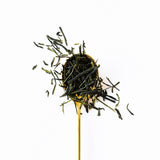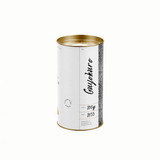1 tsp to 200mL cup
65°C degree water temperature
1 min steep
The same leaf can be used for 3 infusions increasing the time by 30 seconds every time
If you do not have a temperature-controlled kettle we would not recommend this tea. It’s such a precious and rare tea that burns easily without proper brewing.
Camellia Sinensis (the tea plant)
The health properties of green tea (camellia sinensis) have been extensively studied with some of the green tea benefits (especially Gyokuro) showing positive cancer-fighting properties (antiangiogenic) [1, 2, 7, 14, 15, 16] and for protection from cardiovascular diseases [3]. A 2010 literature review [12] summarised green tea as anti-inflammatory [4], antiarthritic [5], antibacterial [6], antioxidative [8, 17], antiviral [9], neuroprotective [10], cholesterol-lowering [11] and fertility improvements in humans and animals [17].
The caffeine and polyphenols found in green tea have also been shown to increase weight loss [13] offering science to the cultural use of green tea for weight loss. One specific polyphenol found in green tea has been the focus of much of the research, epigallocatechin gallate (EGCG), with specific links of EGCG to many of the health properties mentioned earlier [17]. EGCG varies substantially among different types of teas with green teas having the highest concentration. Among green tea there is a large difference as well, ranging from 5.8% EGCG of dry leaf weight to under 1%. Japanese green tea typically has the highest percentage of EGCG with gyokuro being one of the highest of all [18].
1. McKay DL, Blumberg JB. The role of tea in human health: An update. J Am Coll Nutr. 2002;21:1–13. [PubMed] [Google Scholar]
2. Kavanagh KT, Hafer LJ, Kim DW, Mann KK, Sherr DH, Rogers AE, Sonenshein GE. Green tea extracts decrease carcinogen-induced mammary tumor burden in rats and rate of breast cancer cell proliferation in culture. J Cell Biochem. 2001;82:387–398. doi: 10.1002/jcb.1164. [PubMed] [CrossRef] [Google Scholar]
3. Sueoka N, Suganuma M, Sueoka E, Okabe S, Matsuyama S, Imai K, Nakachi K, Fujiki H. A new function of green tea: prevention of lifestyle-related diseases. Ann N Y Acad Sci. 2001;928:274–280. [PubMed] [Google Scholar]
4. Dona M, Dell'Aica I, Calabrese F, Benelli R, Morini M, Albini A, Garbisa S. Neutrophil restraint by green tea: inhibition of inflammation, associated angiogenesis, and pulmonary fibrosis. J Immunol. 2003;170:4335–4341. [PubMed] [Google Scholar]
5. Haqqi TM, Anthony DD, Gupta S, Ahmad N, Lee MS, Kumar GK, Mukhtar H. Prevention of collagen-induced arthritis in mice by a polyphenolic fraction from green tea. Proc Natl Acad Sci USA. 1999;96:4524–4529. doi: 10.1073/pnas.96.8.4524. [PMC free article] [PubMed] [CrossRef] [Google Scholar]
6. Sudano Roccaro A, Blanco AR, Giuliano F, Rusciano D, Enea V. Epigallocatechin-gallate enhances the activity of tetracycline in staphylococci by inhibiting its efflux from bacterial cells. Antimicrob Agents Chemother. 2004;48:1968–1973. doi: 10.1128/AAC.48.6.1968-1973.2004. [PMC free article] [PubMed] [CrossRef] [Google Scholar]
7. Sartippour MR, Shao ZM, Heber D, Beatty P, Zhang L, Liu C, Ellis L, Liu W, Go VL, Brooks MN. Green tea inhibits vascular endothelial growth factor (VEGF) induction in human breast cancer cells. J Nutr. 2002;132:2307–2311. [PubMed] [Google Scholar]
8. Osada K, Takahashi M, Hoshina S, Nakamura M, Nakamura S, Sugano M. Tea catechins inhibit cholesterol oxidation accompanying oxidation of low density lipoprotein in vitro. Comp Biochem Physiol Part C Toxicol Pharmacol. 2001;128:153–164. doi: 10.1016/S1532-0456(00)00192-7. [PubMed] [CrossRef] [Google Scholar]
9. Weber JM, Ruzindana-Umunyana A, Imbeault L, Sircar S. Inhibition of adenovirus infection and adenain by green tea catechins. Antiviral Res. 2003;58:167–173. doi: 10.1016/S0166-3542(02)00212-7. [PubMed] [CrossRef] [Google Scholar]
10. Weinreb O, Mandel S, Amit T, Youdim MBH. Neurological mechanisms of green tea polyphenols in Alzheimer's and Parkinson's diseases. J Nutr Biochem. 2004;15:506–516. doi: 10.1016/j.jnutbio.2004.05.002. [PubMed] [CrossRef] [Google Scholar]
11. Raederstorff DG, Schlachter MF, Elste V, Weber P. Effect of EGCG on lipid absorption and plasma lipid levels in rats. J Nutr Biochem. 2003;14:326–332. doi: 10.1016/S0955-2863(03)00054-8. [PubMed] [CrossRef] [Google Scholar]
12. Chacko S.M., Thambi P.T., Kuttan R., Nishigaki I., Beneficial Effects of Green Tea: A Literature Review. Chin Med. 2010; 5: 13. Published online 2010 Apr 6. Doi: 10.1186/1749-8546-5-13. [PubMed]
13. Huang J., Wang Y., Xie Z., Zhou Y., Zhang Y., Wan X. The anti-obesity effects of green tea in human intervention and basic molecular studies. Eur J Clin Nutr 2014 Oct;68(10):1075-87. doi: 10.1038/ejcn.2014.143. [PubMed]
14. Wang X., Li X., Liang X., Liang J., Zhang C., Yang J., Wang C., Kong D., Sun H. ROS-Responsive Capsules Engineered from Green Tea Polyphenol-Metal Networks for Anticancer Drug Delivery. J. Mater. Chem. B. 2018;6:1000–1010. doi: 10.1039/C7TB02688A. [CrossRef] [Google Scholar]
15. Lambert J.D., Elias R.J. The antioxidant and pro-oxidant activities of green tea polyphenols: A role in cancer prevention. Arch. Biochem. Biophys. 2010;501:65–72. doi: 10.1016/j.abb.2010.06.013. [PMC free article] [PubMed] [CrossRef] [Google Scholar]
16. Posadino A.M., Phu H.T., Cossu A., Giordo R., Fois M., Dtb T., Piga A., Sotgia S., Zinellu A., Carru C., et al. Oxidative stress-induced Akt downregulation mediates green tea toxicity towards prostate cancer cells. Toxicol In Vitro. 2017;42:255–262. doi: 10.1016/j.tiv.2017.05.005. [PubMed] [CrossRef] [Google Scholar]
17. Jin D., Hui W., Zhen-Biao W., Jie Z., Shun Z., Wei L. Protection of murine spermatogenesis against ionizing radiation-induced testicular injury by a green tea polyphenol. Biol. Reprod. 2015;92:1–13. [PubMed] [Google Scholar]
18. Foods to Fight Cancer by Richard Beliveau and Denis Gringras, 2nd Edition, 2017, DK, Penguin Random House. Page 136, Figure 64.





